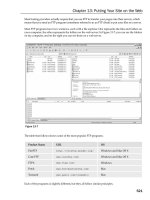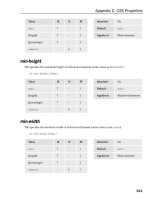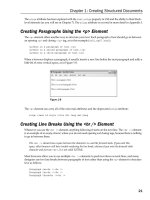Web Programming with Java - Introduction to Java docx
Bạn đang xem bản rút gọn của tài liệu. Xem và tải ngay bản đầy đủ của tài liệu tại đây (565.75 KB, 20 trang )
1
Web Programming with Java
Introduction to Java
Huynh Huu Viet
Email:
Department of Information Systems
2008 © Department of Information Systems - University of Information Technology
2
Outline
What is Java?
A little bit history
Major features
Where Java is used?
Java, the World Wide Web, and Beyond
Key terms
A Simple Java Program
IDE: NetBeans
Resources
Discussion
2008 © Department of Information Systems - University of Information Technology
3
What is Java?
An object-oriented programming language
developed by Sun Microsystems
Also a platform to support Java applications
(technology)
A little bit history
1991: A team led by James Gosling at Sun
Microsystems developed Oak, for use in embedded
consumer electronic appliances
1995: renamed Java - redesigned for developing
Internet applications (Java 1.0 1.1).
1998: Sun announced the Java 2 platform
(1.2,1.3,1.4)
2005 - Now: Java 5 (Java 1.5 - newest version 1.7)
2008 © Department of Information Systems - University of Information Technology
4
Java major features (1)
Simple
A bit easier C++.
The clean syntax
Object-Oriented
Reuse code
Distributed
Designed to make distributed computing easy
Writing network programs as sending and receiving
data to and from a file.
Secure:
Based on the premise that nothing should be trusted.
2008 © Department of Information Systems - University of Information Technology
5
Java major features (2)
Platform-independent
One program that will run on any platform with
JVM
Portable
Java programs can be run on any platform
without being recompiled
Multithreaded
Program’s capability to perform several tasks
simultaneously.
A necessity in multimedia and network
programming
2008 © Department of Information Systems - University of Information Technology
6
Where Java is used?
Desktop standalone applications
Web applications
Client side: applets
Server side: Java servlets or JavaServer
Pages (JSP)
Embedded applications for small
hand-held devices
2008 © Department of Information Systems - University of Information Technology
7
Key terms(1)
Java language specification (JLS):
Syntax and semantics of the Java programming
language
Java API
Predefined classes and interfaces for developing
Java programs
JLS is stable, but the API is still expanding
Java API – 3 Editions
Java 2 Standard Edition (J2SE): develop client-side
standalone applications or applets
Java 2 Enterprise Edition (J2EE): develop server-side
applications: Java servlets and JavaServer Pages
Java 2 Micro Edition (J2ME): develop applications for
mobile devices
2008 © Department of Information Systems - University of Information Technology
8
Key terms(2)
JDK- Java Development Kit ( SDK -System
Development Kit)
Programs for developing and testing Java programs
JRE - Java Runtime Environment
Programs for running Java programs
Includes: interpreter, core classes, and supporting files
A subset of JDK
IDE- Integrated Development Environment
Java development tool for rapidly developing Java programs
Three major IDE:
• JBuilder by Borland ( />• NetBeans Open Source by Sun ( />)
• Eclipse Open Source by IBM ( />)
2008 © Department of Information Systems - University of Information Technology
9
Key terms(3)
2008 © Department of Information Systems - University of Information Technology
10
A Simple Java Program(1)
2008 © Department of Information Systems - University of Information Technology
11
A Simple Java Program(2)
2008 © Department of Information Systems - University of Information Technology
12
Anatomy of a Java Program
Comments
Reserved words
Modifiers
Statements
Blocks
Classes
Methods
The main method
2008 © Department of Information Systems - University of Information Technology
13
Anatomy of a Java Program(1)
Comments
Line comment: //
Paragraph comment : /*…*/
Reserved words or keywords
Have a specific meaning to the compiler: class, public…
Java is case-sensitive
Modifiers
Keywords that specify the properties of the data,
methods, and classes and how they can be used.
public, static, private, final, abstract, and protected
Statements
Represents an action or a sequence of actions.
2008 © Department of Information Systems - University of Information Technology
14
Anatomy of a Java Program(2)
Blocks
Begins with an opening brace ({)
Ends with a closing brace (}).
Classes
The essential Java construct
Java program is classes
Methods:
Consists of a collection of statements that perform a
sequence of operations.
The main method
Defines where the program execution begins
2008 © Department of Information Systems - University of Information Technology
15
Netbeans (1)
2008 © Department of Information Systems - University of Information Technology
16
Netbeans (2)
Sun’s free, open source IDE for Java
Written in Java, available on any
platform that Java is available on
Supports plugins for working in other
languages as well, such as C and C++.
Current Version
Stable: Netbeans IDE 6.1
Beta: Netbeans IDE 6.5
Available:
2008 © Department of Information Systems - University of Information Technology
17
Netbeans (3)
2008 © Department of Information Systems - University of Information Technology
18
Resources
JDK 6:
/> Java API (chm format):
/> Netbeans IDE:
/> Text Books:
More information at UIT Forum – Course sub-
forum
2008 © Department of Information Systems - University of Information Technology
19
Readings & Exercise
Further Readings
Chapter 1 [1], Chapter 2 [3]
Exercises:
[1]: 1.1
[3]: 2.14
Next week readings:
[1]: Chapter 2,3,4
2008 © Department of Information Systems - University of Information Technology
20
Discussion









